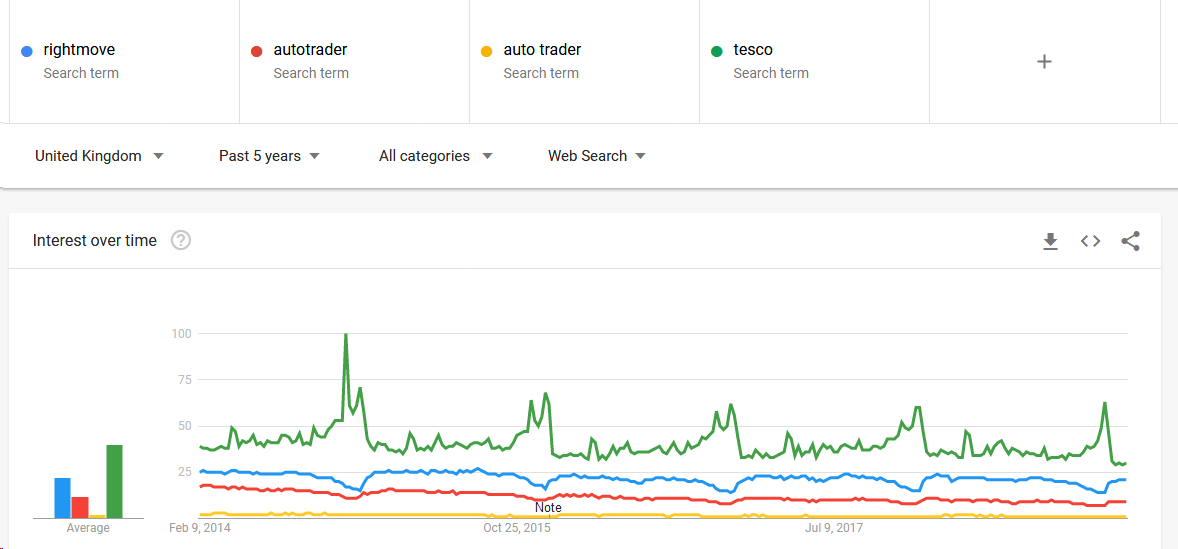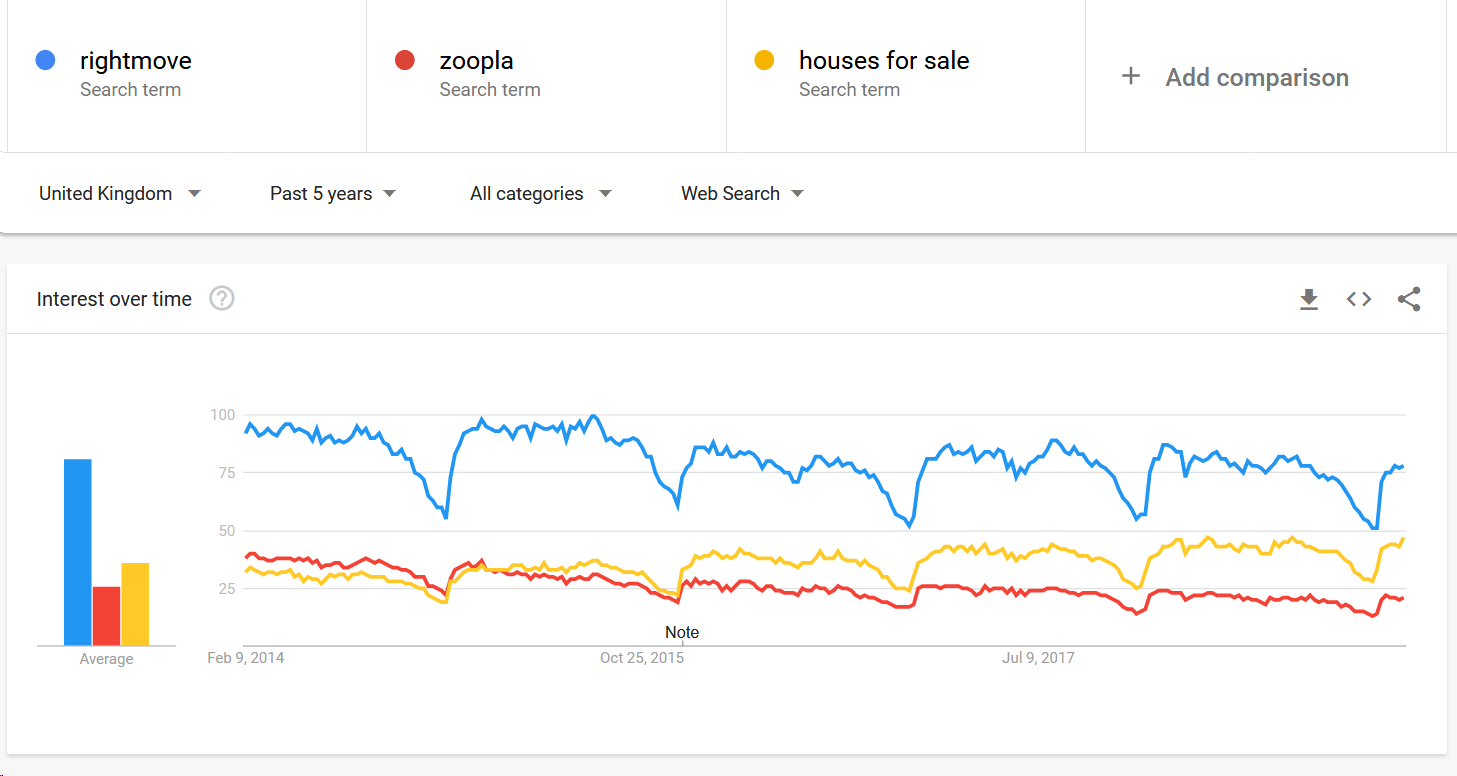In this post, I’m going to explore why large, well-known brands can run into difficulties with organic performance, the patterns I’ve noticed, and some of the recommended tactics to address those challenges. Given that large, well-known brands aren’t performing well, one would think that less known brands (brands that don’t fit the above description) would be closing the gap. Reason 1: Brand Quite possibly the biggest hurdle standing in the way of a brand’s performance is the brand itself. That in and of itself should help them in SEO, right? Here's how the above name-brand examples are performing on search: Other dominant, clearly vertical-leading brands in the UK, in general, are also not doing so well in branded search: There’s a lot of potential reasons for why this may be — and we’ll even address some of them later — but a few notable ones include: Complacency — particularly for brands that were early juggernauts of the web, they may have forgotten the need to reinforce their brand image and recognition. In fairness, it’s easy to see why — these channels and approaches likely have the least measurable returns. As a result, it’s become common-place to see plucky, younger businesses rising quickly, and, at the very least, increasing the apparent level of choice where historically a legacy business might have had a monopoly on basic competence. Most SEOs agree that SERP behavior factors into rankings, so it’s easy to imagine legacy businesses, which disproportionately have a premium angle, struggling for clicks vs. attractively priced competitors. Google does not understand or care that you have a premium proposition — they’ll throw you in with the businesses competing purely on price all the same. Reason 5: Super-aggregators (Amazon, Google) In a lot of verticals, the pie is getting smaller, so it stands to reason the dominant players will be facing a diminishing slice.

Given the increasing importance of brand in SEO, it seems a cruel irony that many household name-brands seem to struggle with managing the channel. Yet, in my time at Distilled, I’ve seen just that: numerous name-brand sites in various states of stagnation and even more frustrated SEO managers attempting to prevent said stagnation.
Despite global brand recognition and other established advantages that ought to drive growth, the reality is that having a household name doesn’t ensure SEO success. In this post, I’m going to explore why large, well-known brands can run into difficulties with organic performance, the patterns I’ve noticed, and some of the recommended tactics to address those challenges.
What we talk about when we talk about a legacy brand
For the purposes of this post, the term “legacy brand” applies to companies that have a very strong association with the product they sell, and may well have, in the past, been the ubiquitous provider for that product. This could mean that they were household names in the 20th century, or it could be that they pioneered and dominated their field in the early days of mass consumer web usage. A few varied examples (that Distilled has never worked with or been contacted by) include:
- Wells Fargo (US)
- Craigslist (US)
- Tesco (UK)
These are cherry-picked, potentially extreme examples of legacy brands, but all three of the above, and most that fit this description have shown a marked decline in the last five years, in terms of organic visibility (confirmed by Sistrix, my tool of choice — your tool-of-choice may vary). It’s a common issue for large, well-established sites — peaking in 2013 and 2014 and never again reaching those highs.
Given that large, well-known brands aren’t performing well, one would think that less known brands (brands that don’t fit the above description) would be closing the gap. But it’s the opposite. In fact, said brands are under-performing in organic and showing signs of stagnation — and they aren’t showing any signs of catching up.
The question is: why does it keep happening?
Reason 1: Brand
Quite possibly the biggest hurdle standing in the way of a brand’s performance is the brand itself. This may seem like a bit of an odd one — we’d already established that the companies we’re talking about are big, recognized, household names. That in and of itself should help them in SEO, right?
The thing is, though, a lot of these big household names are recognized, but they’re not the one-stop shops that they used to be.
Here’s how the above name-brand examples are performing on search:



Other dominant, clearly vertical-leading brands in the UK, in general, are also not doing so well in branded search:

There’s a lot of potential reasons for why this may be — and we’ll even address some of them later — but a few notable ones include:
- Complacency — particularly for brands that were early juggernauts of the web, they may have forgotten the need to reinforce their brand image and recognition.
- More and more credible competitors. When you’re the only competent operator, as many of these brands once were, you had the whole pie. Now, you have to share it.
- People trust search engines. In a lot of cases, ubiquitous brands decline, while the generic term is on the rise.
Check out this for the real estate example in the UK:

Rightmove and Zoopla are the two biggest brands in this space and have been for some time. There’s only one line there that’s trending upwards, though, and it’s the generic term, “houses for sale.”
What can I do about this?
Basically, get a move on! A lot of incumbents have been very slow to take action on things like top-of-funnel content, or only produce low-effort, exceptionally dry social media posts (I’ve posted before about some of these tactics here.) In fairness, it’s easy to see why — these channels and approaches likely have the least measurable returns. However, leaving a vacuum higher in your funnel is playing with fire, especially when you’re a recognized name. It opens an opportunity for smaller players to close the gap in recognition — at almost no cost.
Reason 2: Tech debt
I’m sure many people reading this will…

COMMENTS